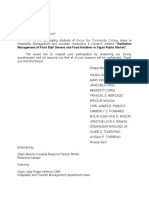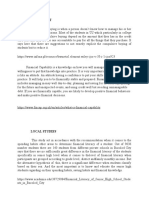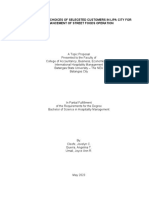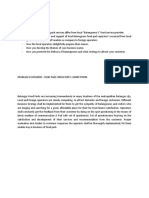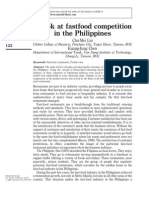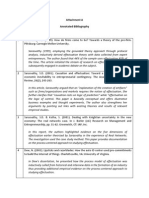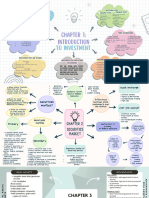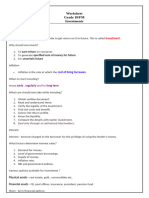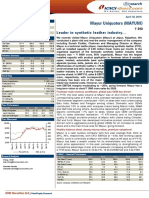A Look at Fastfood Competition in The Philippines
A Look at Fastfood Competition in The Philippines
Uploaded by
Pamela Fuentes ResurreccionCopyright:
Available Formats
A Look at Fastfood Competition in The Philippines
A Look at Fastfood Competition in The Philippines
Uploaded by
Pamela Fuentes ResurreccionOriginal Title
Copyright
Available Formats
Share this document
Did you find this document useful?
Is this content inappropriate?
Copyright:
Available Formats
A Look at Fastfood Competition in The Philippines
A Look at Fastfood Competition in The Philippines
Uploaded by
Pamela Fuentes ResurreccionCopyright:
Available Formats
The current issue and full text archive of this journal is available at http://www.emerald-library.
com
BFJ 102,2
A look at fastfood competition in the Philippines
Chihlee College of Business, Panchiao City, Taipei Hsien, Taiwan, ROC Department of International Trade, Van Nung Institute of Technology, Chung-Li, Taiwan, ROC
Keywords Fast-food restaurants, Product mix Abstract The study tried to develop a product-market structure of the fast-food restaurants in the Philippines. Using the concept of hierarchical clustering based on substitution-in-use, the influence of three categories of situational influence were used to modify the original choicemarket mix relationship at every clustering stage. Changes in the importance of the individual components of the product-service mix served as the basis of the link-up among competing fastfood restaurants.
Chu-Mei Liu
122
Kuang-Jung Chen
British Food Journal, Vol. 102 No. 2, 2000, pp. 122-133. # MCB University Press, 0007-070X
Restaurants are part of an industry system, providing services to people away from home that becomes progressively more general and broader as it moves from restaurants to food services to hospitality industry. It is towards this sophistication of man's basic needs and his complex life that fast-food restaurants emerged. Fast-food restaurants are a breakthrough from the traditional catering methods and standards. They have resulted in more sophisticated operations and styles for services. They have provided flexibility and comfort with reasonable prices. Their services are within the level that can satisfy customers with various tastes, drives, and upbringing. Customer satisfaction has been one of the measurable objectives of other service-oriented establishments. It is to the satisfaction of the customer's needs that the business strives. Without the support of customers and satisfaction of their wants, the existences of fast-food restaurants would be in jeopardy. A satisfied customer would always go back to the same fast-food establishment where his wants and preferences were not merely met but also complemented (Reyes, 1996). The satisfaction of customer preferences, in effect, constitutes the image of the particular fast-food restaurant and plays an important role in the business industry. The Philippine Star (1997) described the Filipinos as food lovers. They enjoy tasty meals. They go to restaurants serving smorgasbords in a luncheon or supper buffet offering a variety of foods and dishes. These restaurants, most especially, attract students. They are the group of people that regularly patronize fast-food restaurants, which accounts for the sudden boom in the fast-food industry in the Philippines. During the past few years, the fast-food industry in the Philippines achieved a tremendous growth, not only in Metro Manila, but also in all other areas of the country. This situation makes the fast-food industry in the Philippines a
thriving ground of intense competition among the players in the industry. Prior and during the current financial crisis that hit the Asian region, patronage of fast-food establishments continues to grow while there is perceived slow down in other business sectors (HRAP, 1998). Foreign-based fast-food chains joined the already tight roster of fast-food establishments operating in the country. How does the competitive structure of the industry now appear? Introduction Fast-food restaurants have their own benefits, which their customers perceive. These perceived benefits are the primary reasons why they are patronized. Consumers rate these benefits or the values that they see in the product. Detailed information on the preferences of these consumers is revealed through representative samples of how they rate the importance of such benefits. Certainly, most people would like as many benefits as possible. However, the relative importance they attach to individual benefits can differ significantly and these can be used as effective barometers in segmenting the markets. Astute marketers have long realized that in addition to brand image, their company image can strongly influence consumer's behavior toward their enterprise and its products (Kasulis and Lusch, 1981). A company's image is the perception consumers have of its character as a result of their experience with it and their knowledge of and beliefs about it. Similarly, consumer patronage of a particular retail store can also be significantly influenced by their perception of its image or personality. Store image may be defined as the way in which the store is defined in the shopper's mind, partly by its functional qualities and partly by an aura of psychological attributes (Pessemier, 1980). This definition implies that the fast-food restaurant image could be derived from the so-called functional attributes of price, convenience, and selection of menu. Variables such as architecture, interior design and advertising could influence a restaurant's image as well. Therefore, consumers can develop images of fast-food restaurants regardless of whether management consciously attempts to project a specific image or not. For this reason, it is important for management to understand their image, as consumers perceive it. If the consumers' criteria for selecting a particular restaurant from among other competitors can also be identified, then management can determine how the restaurant is evaluated or measured. Markets consist of various buyers, and buyers differ in one or more respects. They may differ in their wants, resources, geographical locations, buying attitudes, lifestyles, and buying practices. Any of these variables can be used to segment a market. Market segmentation reveals the potential market opportunities facing the establishment. The establishment now has to evaluate the various segments and decide on which segment or segments to serve. The question of how many segments to serve can also be addressed, either to increase market share or develop niches, as a competitive strategy. The establishment, in evaluating different market segments, must look at factors
A look at fastfood competition 123
BFJ 102,2
124
such as segment size and growth, segment structural attractiveness, and company objectives and resources. Within each segment, the establishment needs to develop a product-positioning strategy. According to Kotler (1994), positioning is the act of designing the company's offering and image so that it occupies a distinct and valued place in the target customer's mind. The management of a fast-food establishment therefore, needs to describe to his customers how his store differs from current and potential competitors. Using his store attributes, he can project an image or personality that directly influences the consumer patronage of the store. It is then ultimately the consumer's perception of all the competing outfits that will decide or establish the mode of direct or indirect competition among industry participants. This picture is captured in the product-market structure. It is the purpose of this study to establish the current product-market picture of the Philippine fast-food industry and determine the forces that are responsible for the structural linkages. Related literature Chase (1988) describes a restaurant as a high contact service enterprise with the following characteristics: . The service product is multidimensional and hence its quality is in the eyes of the beholder. . The direct worker is part of the service product. . Demand for the service is often instantaneous and hence cannot be stored. . Because the product is generally customer initiated, an optimal balance between service system demand and resources is difficult to achieve. . Changes in the capacity of the system affect the nature of the service product. . The production schedule has a direct, personal effect on the consumer. . Only part of the service can be kept in inventory. . Verbal skills and knowledge of policy are usually required of the service worker. . Wage payment must usually be related to labor hours spent rather than output. . It is assumed that service system capacity is at its long run level when the system first opens. . A service system malfunction will have an immediate, direct effect on the customer. Because of the multidimensional nature of restaurant service, the application of the hospitality marketing mix of Renaghan (1981) appears to be imperative. The mix contains three major sub-mixes of clearly delineated but interrelated
elements. The Product-Service Mix the combination of the tangible and intangible offerings of the establishment presented as its product aimed at satisfying the needs of the target market. This mix highlights the fact that consumers do not perceive the product and service elements separately but as a unified whole. The Presentation Mix is an umbrella concept covering the elements under the firm's control that act in concert to make the total productservice offering more tangible to the consumer. In effect, management combines tangibles to serve as surrogates of the intangible components of the offering. It is through the presentation mix that the firm tries to differentiate its offering from those of its competitors. The Communication Mix include all the communications between the firm and the target market. External communication is intended to persuade the consumer to use the establishment. It is usually applied when the consumer is not actually in the establishment. Internal communications are used when the consumer is already within the establishment and actually consuming the product. Mazursky and Jacoby (1986) pointed out that the various determinants of store choice are intimately related to a store image that influences its attracting power. Demographic characteristics, life-style characteristics, and other consumer characteristics lead to general opinions and activities concerning shopping and search behavior. These consumer characteristics also affect the importance which they place on store attributes as they evaluate their alternatives. The consumer's store attitudes then influences store choice and ultimately, the product and brand-choice decision. Satisfaction, in the process, leads to reinforcement in the store's image, which increases the likelihood of continued patronage and greater store loyalty (Hawkins et al., 1992). Seldom do you hear customers categorically stating that the store's physical plant was the basis of their choice. Yet studies show that food-service customers begin to formulate opinions about a food-service operation long before they sample the food and beverage items. While they are still outside the physical confines of the operation, opinions are being formulated about the exterior architecture and landscaping. These initial opinions are carried inside once the customer has entered. They are either dispelled or reinforced by the interior design and lighting. All internal and external factors combine to provide the customer with a ``total experience''. If any part of this experience is not up to the expectations of the customer, the customer may not return, and may tell their friends about their poor experiences (National Restaurant Association (NRA) 1994). In the Philippines, especially in urban centers, fast-food restaurants are often clustered along one street. Clustering is commonly explained by factors such as easy place association and attraction. Customers are willing to travel a distance to locate the right offering and once they arrive in the locale, clustering gives them in-situ options to choose from. Availability of options reduces the cost of making the wrong decision, a benefit they traded for the cost of travel. NRA also found that consumers do not go far out of their way to
A look at fastfood competition 125
BFJ 102,2
126
find the right fast-food restaurant. It appears that the use of a fast-food restaurant is attached to the urgency of the need for food, either physiological or social (NRA 1994). Saavedra (1983) cited various menus being offered by fast food restaurants as the main reason, aside from excellent service and ambience, that make one's meal truly worthwhile. Kotler (1994) opines that atmospherics affect purchase behavior by acting as an attention-getting, message-creating, or emotion-creating medium. Understanding a buyer's needs and buying behavior is better achieved by knowing the reasons why people dine outside the home. Records of the Philippine Hotel and Restaurant Association indicate that Filipinos commonly cite the following reasons for dining outside their home. . A treat. . Business requires it. . Celebrate special occasions. . Change of pace. . Convenient. . Enjoy good food. . For food not usually available at home. . Good way to entertain guest. . Good way to relax. . Nobody has to cook or clean up. . Prices are reasonable. . Spouse requests to eat out. . Whole family enjoys themselves. Lovelock (1983) cited that the restaurant's nature of service delivery is considered as a discrete transaction. The marketers tend to be less informed about who their customers are and what use each customer makes of the service. The extent to which service characteristics are customized is high. However, the extent to which customer-contact personnel exercise judgment in meeting an individual customer's needs is low. The extent of demand fluctuation over time is wide and peak demand regularly exceeds capacity. To complicate things further, the purchase and consumption situation exerts an influence on consumer decision making. Belk (1974) identified five groups of situational influences: (1) Physical surroundings the most readily apparent features of a situation. These features include geographical and institutional location, decor, sounds, aromas, lighting, weather, and visible configurations of merchandise or the material surrounding the stimulus object.
(2) Social surroundings provide additional depth to a description. Other persons present, their characteristics and their apparent roles. (3) Temporal perspective dimension of situation, which may be specified in units ranging from time of day to season of the year. (4) Task definition the feature that includes an intent or requirement to select, shop for/or obtain information about a general or specific purchase. (5) Antecedent states the momentary moods or momentary conditions. Fast-food restaurants and customers do not exist in a vacuum but are embedded in an environment. Studies found evidence indicating that the intended or anticipated use of the product, the functions to be served, the application/consumption context, or in general the usage situation, influence the choice among products/brands and, consequently, substitutability. It is to this premise that this study concerned itself in the establishment of a competitive picture of the fast-food restaurants operating in Metro-Manila. Methodology This study capitalized on the approach of Srivastava et al. (1981, 1984) in establishing the product-market structure of financial services. A slight modification of the analysis, however, is necessary in order to capture the differences of the influence of Belk's situational influences. In the estimation of the beta coefficient of the different independent variables (attributes and features of the fast-food restaurant) used to influence fast-food restaurant choice, stage-wise multiple regression was used. Initially, choice was regressed with the situational variables. Step-wise regression was done in order to determine the strength or degree of influence of the different groups of situational influences and only those significant will be utilized in the stagewise regression stage. Having established the sequence of the introduction of the situational variables, the development of the product-market structure was undertaken. The initial regression run was executed using simultaneously only the ten variables used to describe the fast-food restaurant product-service mix, namely: fast and quick service; good value for money; food taste/flavor; variety of food offerings; music and noise level; attractive decor; atmosphere and ambience; promotional gimmicks and items; friendly and pleasant staff, and cleanliness and neatness. It must be noted that it is through these variables that the competing firms try to differentiate their offerings to the consumers. It is therefore expected that each fast-food restaurant will endeavor to present a unique image or distinctive profile. In order to capture this concept a separate regression run was done for each restaurant. Temporal variables (breakfast, lunch, and dinner) were then included in the evaluation of the choice of each restaurant. Hierarchical clustering of the
A look at fastfood competition 127
BFJ 102,2
128
restaurant was done using the beta coefficients as a basis for the clustering procedure. The first restaurants joined by the clustering procedure were treated as a single unit in the succeeding step. Social surrounding variables (alone, with friends, with clients) were included in the next regression analysis of the individual restaurants, including the joined firms in the previous stage, now taken as a single restaurant. Again, with the beta coefficients as a basis, another hierarchical clustering was undertaken. The foregoing steps were repeated in the inclusion of task definitional (socialization, business, celebration) variables. The data used in the forgoing analysis was generated through a survey using flash cards. A total of 1,365 respondents were randomly selected in different fast-food restaurants situated in Metro Manila using the list taken from the Department of Trade and Industry and Hotel and Restaurant Association of the Philippines as reference. The importance of the product-service mix variables in the choice of fastfood restaurants was elicited by the first set of cards shown to the respondents. In the second set of cards, the respondents were requested to identify (write) at least five fast-food restaurants they usually patronize. Thereafter, these cards were used in assessing choice when a particular situation was present. The respondents were requested to arrange the cards in descending priority when a situation was given. A total of 156 fast-food restaurants were identified. In the final analysis, however, only 26 brand names were used. Fast-food restaurants that did not meet the necessary number (50) needed in the regression analysis were dropped from the list. Likewise, similar franchised brand names located in different places were consolidated as one brand. Results Individual regression was done on each destination and the coefficient served as inputs in the hierarchical cluster analysis undertaken using average linkage between groups as criteria. Agglomeration normally results in the reduction of the amount of variation explained by a model. To determine the appropriate tradeoff level, regression analysis was done for each stage of agglomeration. The fast-food restaurants appearing in the Cluster 2 column or Table I were not included in the analysis for the specific stage. Estimated R-squared values were transformed into unexplained variances and plotted to visualize the location of the ``elbow'' point (Hair et al., 1995). The elbow occurred at nine clusters, equivalent to the 17th stage of the agglomeration process (Figure 1). At the cut-off point, six fast-food restaurants remain unattached and the other three clusters were generated as results of the tie-up of several fast-food restaurants. Cluster 1, 3, 4, 6, 8, and 9, contain only one fast-food restaurant and all of them are franchised brands and have branches inside shopping malls. It appears that loyal customers patronize these fast-food restaurants. The importance attached by the customers to fast and quick service, music and noise level, attractive decor, atmosphere and ambience, promotional gimmicks
Stage 1 2 3 4 5 6 7 8 9 10 11 12 13 14 15 16 17 18 19 20 21 22 23 24 25
Clusters combined Cluster 1* Cluster 2* Brand Brand Brand Brand Brand Brand Brand Brand Brand Brand Brand Brand Brand Brand Brand Brand Brand Brand Brand Brand Brand Brand Brand Brand Brand 1 2 3 4 5 6 7 8 9 10 11 12 13 14 15 16 17 18 19 20 21 22 23 24 25 Brand Brand Brand Brand Brand Brand Brand Brand Brand Brand Brand Brand Brand Brand Brand Brand Brand Brand Brand Brand Brand Brand Brand Brand Brand 1 2 3 4 5 6 7 8 9 10 11 12 13 14 15 16 17 18 19 20 21 22 23 24 25
Coefficient 120.1679 152.1355 431.7078 1,003.4598 1,460.0529 2,961.1577 3,436.3215 3,751.3496 4,470.4849 6,146.7056 6,155.7632 8,440.8389 8,930.8828 10,430.2549 14,278.8408 14,600.7510 15,968.3545 17,593.6543 20,504.8047 21,242.9102 27,486.2246 32,641.5996 44,443.8281 54,835.1797 88,964.8516
Stage cluster first appears Cluster 1 Cluster 2 Next stage 0 0 0 0 4 5 0 0 7 0 0 10 0 12 14 0 9 15 0 18 20 21 22 0 24 0 0 1 0 3 0 0 2 0 6 0 0 11 13 8 0 0 0 17 16 0 19 0 0 23 3 8 5 5 6 10 9 15 17 12 13 14 14 15 18 20 19 20 22 21 22 23 25 25 0
A look at fastfood competition 129
Notes: * For consistency actual names are disguised because of the request of the firms
Table I. Agglomeration schedule using average linkage (between groups)
Elbow point 0.4 0.3 1-R2 0.2 0.1 0 1 3 5 7 9 11 13 15 17 19 21 23 25 Number of Clusters
Figure 1.
and items, friendly and pleasant staff, and cleanliness and neatness changed in various directions depending on the situational context that entered the model. However, good value for money, food taste/flavor and variety of food offerings practically remain unchanged. It does appear that the perception of the customers relative to these three attributes provides a unique identity for the franchised group of fast-food restaurant. This perception remains unchanged regardless of the situation context present.
BFJ 102,2
130
Cluster 7 consists of fast-food restaurants under the sub-grouping called ``carenderias'' popularly known as ``turo-turo''. During the introduction of the temporal situation variable Brands 24, 25, 11, 4, 26 and 10 joined together forming subgroup A. Brands 16 and 17 were separately linked forming subgroup B. In the succeeding clustering iteration, Brand 2 was linked to subgroup A and Brand 6 linked up with sub-group B. Sub-group C was generated through the link-up of Brands 9 and 14. During the next clustering iteration, Brand 15 linked up with sub-group A, Brand 7 joined subgroup C. When social surroundings were included in the modeling process, all the three sub-groups were linked as one cluster. Fast and quick service, food taste/flavor, variety of food offerings, and friendly and pleasant staff are the variables responsible for the joining of the carenderias into subgroups. Changes in the coefficients relative to variety of the food offerings cause the delay in the link-up of the other brands. And value of money was responsible for the final link-up of the subgroups to form Cluster 7. Another point worth mentioning regarding the initial grouping of the fastfood restaurant in sub-groups A and B is the fact that all start serving their customers at breakfast time. Furthermore, the firms in subgroup A during the initial formation are near each other. This tends to show that location and time of operation appear to be factors to reckon with. Brands 5, 22, 12 and 20 are fast-food restaurants that operate on a 24-hour basis. They are all situated in areas near hospitals or at junctions of main roads. Basically, their cleanliness and neatness, music and noise level, attractive decor, atmosphere and ambience, and friendly and pleasant staff stand out as variables responsible for the link-up. Brand 8 and 21 are fast-food restaurants situated in a sort of mobile-type venue. Brand 21 operates on a 24-hour basis. Cleanliness and neatness and friendly and pleasant staff are the variables that linked them up and at the same time separates them from the carenderias. Overall, social surroundings greatly affected the importance of good value for money, food taste/flavor, variety of food offerings, music and noise level, attractive decor, atmosphere and ambience, friendly and pleasant staff, and cleanliness and neatness. The common tendency is an increase in the importance of these variables as the situation changes from alone, to with friends and highest if with clients. With the inclusion of task definition in the model, minimal increase in the importance of the following variables was registered: food taste/flavor, variety of food offerings, music and noise level, attractive decor, atmosphere and ambience, friendly and pleasant staff, and cleanliness and neatness. Speed of service is also affected. The final product-market structure of the fast-food restaurant using the rescaled distance cluster combine is presented in Figure 2. As one moves from the left side of the figure to the right, the scales show that the distance between
Brand 24 Brand 25 Brand 11 Brand 4 Brand 26 Brand 10 Brand 2 Brand 15 Brand 9 Brand 14 Brand 7 Brand 16 Brand 17 Brand 6 Brand 13 Brand 8 Brand 21 Brand 23 Brand 5 Brand 22 Brand 12 Brand 20 Brand 3 Brand 18 Brand 1 Brand 19
A look at fastfood competition 131
Elbow point
Figure 2. Product-market structure of Philippine fast-food restaurant
the clusters increases and the degree of substitution between groups becomes weaker. The number of fast-food restaurants in a cluster however also increases, making direct competition among these restaurants within the cluster tighter.
BFJ 102,2
132
Conclusion and managerial implications The structure established shows the relative picture of the competitive situation of the fast-food restaurants in Metro Manila, Philippines. The apparent easy start-up of carenderias generated the tightness of the competition in this sub-group of fast-food restaurants. Since the franchised brands are normally supported financially, loyalty and apparent service to a particular niche enhance their ability to create good images that result in a strong customer loyalty. Although a product market structure was successfully established, the use of approaches that can capture the interactions among situation, person, and product factors, might produce an improved picture. This is particularly so because it is possible that a simultaneous situation could occur or multiple uses of the fast-food restaurant can also happen. As such, it might be necessary to relax the one membership rule and allow the presence of overlapping clusters.
References Belk, R.W. (1974), ``An exploratory assessment of situational effects in buyer behavior'', Journal of Marketing Research, May. Chase, R.B. (1988), ``The customer contact approach to services: theoretical bases and practical extension'', in Lovelock, C. (Ed.), Managing Services: Marketing Operations and Human Resources, Prentice-Hall, Englewood Cliffs, NJ. Hair, J.F. Jr, Anderson, R.E., Tatham, R.L. and Black, W.C. (1995), Multivariate Data Analysis With Readings, 4th ed., Prentice-Hall, Englewood Cliffs, NJ. Hawkins, D.I., Best, R. and Coney, K.A. (1992), Consumer Behavior: Implications for Marketing Strategy, Richard D. Irwin, Homewood, IL. HRAP Bulletin (1998). Kasulis, J.J. and Lusch, R.F. (1981), ``Validating the retail store image concept'', Journal of the Academy of Marketing Science, Fall. Kotler, P. (1994), Marketing Management, 8th ed., Prentice Hall, Englewood Cliffs, NJ. Lovelock, C.H. (1983), ``Classifying service to gain strategic marketing insights'', Journal of Marketing, Summer. Mazursky, D. and Jacoby, J. (1986), ``Exploring the development of store images'', Journal of Retailing, Summer. National Restaurant Association (1994), Fast Food Restaurant Survey, Fast Food Restaurant Association of the Philippines. Pessemier, E.A. (1980), ``Store image and positioning'', Journal of Retailing, Spring. (The) Philippine Star (1997), www.philstar.com Renaghan, L.M. (1981), ``New marketing mix for the hospitality industry'', The Cornell Hotel and Restaurant Administrative Quarterly, August. Reyes, M. (1996), HRAP Bulletin. Saavedra, R. (1983), ``The marketing strategies of fast food restaurants: an analysis'', (unpublished). Srivastava, R., Alpert, M.I. and Shocker, A.D. (1984), ``A customer-oriented approach for determining market structures'', Journal of Marketing, Spring. Srivastava, R., Leone, R.P. and Shocker, A.D. (1981), ``A market structure analysis: hierarchical clustering of products based on substitution-in-use'', Journal of Marketing, Summer.
Further reading Anonuevo, M.V.E. (1984), Principles of Marketing Management, National Book Store, Manila. Backus, H. (1977), Designing Restaurant Interiors: A Guide for Food Service Operators, LebharFriedman, New York, NY. Dickson, P. (1982), ``Person-situation: segmentation's missing link'', Journal of Marketing, Fall. Dillion, W.R., Madden, T.J. and Firtle, N.H. (1984), Marketing Research in Marketing Environment, Times Mirrow/Mosby College Publishing, Richard D. Irwin, Homewood, IL. Firnstahl, T.W. (1989), ``My employees are my service guarantee'', Harvard Business Review, July and August. George, W.R. (1977), ``The retailing of services a challenging future'', Journal of Retailing, Fall. Heskett, J.L. (1987), ``Lesson in the service sector'', Harvard Business Review, March-April. Kotler, P. (1974), ``Atmospherics as a marketing tool'', Journal of Retailing, Winter. Lambert, C. (1981), ``Environmental design: the food-service manager's role'', The Cornell Hotel and Restaurant Quarterly, May. Leigh, J.H. and Martin, C.K. Jr (1981), ``A review of situational influence paradigms and research'', in Enis, B. and Roering, K. (Eds), Review of Marketing, American Marketing Association, Chicago, IL. Milliman, R.E. (1986), ``Influence of background music on the behavior of restaurant patrons'', Journal of Consumer Research, September. Philippine Agribusiness and Food Market (1996), Green Pages Publishing Corporation. Schmenner, R.W. (1986), ``How can service businesses survive and prosper?'', Sloan Management Review, Spring. Surprenant, C.F. and Solomon, M.R. (1987), ``Predictability and personalization in the service encounter'', Journal of Marketing, April.
A look at fastfood competition 133
You might also like
- Let's Go South? The Reasons and Solutions To The Conflict in MindanaoNo ratings yetLet's Go South? The Reasons and Solutions To The Conflict in Mindanao21 pages
- Dadiangas North High School: Republic of The PhilippinesNo ratings yetDadiangas North High School: Republic of The Philippines25 pages
- A Feasibility Study On A Mobile Food Cart Business in Pampanga Chapter One100% (1)A Feasibility Study On A Mobile Food Cart Business in Pampanga Chapter One9 pages
- Postor Allyah Paula Chicken Wings Market ResearchNo ratings yetPostor Allyah Paula Chicken Wings Market Research30 pages
- States As Targets: The Rise of Transnational Activism100% (1)States As Targets: The Rise of Transnational Activism3 pages
- Revisiting Customers' Perception of Service Quality in Fast Food RestaurantsNo ratings yetRevisiting Customers' Perception of Service Quality in Fast Food Restaurants13 pages
- Customer Loyalty in The Fast Food Restaurants of Bangladesh: British Food Journal September 2019No ratings yetCustomer Loyalty in The Fast Food Restaurants of Bangladesh: British Food Journal September 201926 pages
- ASSIGMENT On Problem Statement of McDonaldNo ratings yetASSIGMENT On Problem Statement of McDonald2 pages
- Polytechnic University of The Philippines: Sari Heartland - The Local VillageNo ratings yetPolytechnic University of The Philippines: Sari Heartland - The Local Village40 pages
- in Your Opinion, How Do Cultural Norms Affect A Company or An Organization?No ratings yetin Your Opinion, How Do Cultural Norms Affect A Company or An Organization?1 page
- Cultural Targeting A Key To On Line Consumer Receptivity (EM)0% (1)Cultural Targeting A Key To On Line Consumer Receptivity (EM)28 pages
- Trade Analysis of Nfa Rice in Cavite Ralph John Abad Yasmin AgronNo ratings yetTrade Analysis of Nfa Rice in Cavite Ralph John Abad Yasmin Agron65 pages
- Impact of Korean Restaurants To The Community in Olongapo CityNo ratings yetImpact of Korean Restaurants To The Community in Olongapo City13 pages
- Consumer Behavior On Fast Food in Bangladesh78% (9)Consumer Behavior On Fast Food in Bangladesh31 pages
- Chap 1 3 Street Foods Choices Customers in Lipa City 1No ratings yetChap 1 3 Street Foods Choices Customers in Lipa City 139 pages
- The A's Corner Food Truck (Marketing Plan)No ratings yetThe A's Corner Food Truck (Marketing Plan)11 pages
- Marketing Performance of Purified Water Refilling Stations in MintalNo ratings yetMarketing Performance of Purified Water Refilling Stations in Mintal4 pages
- Philippine Christian University: Senior High School Department Dasmariñas Campus100% (1)Philippine Christian University: Senior High School Department Dasmariñas Campus15 pages
- Chap 1 3 Street Foods Choices Customers in Lipa City 1No ratings yetChap 1 3 Street Foods Choices Customers in Lipa City 137 pages
- The Transformation of Food Retail in The PhilippinNo ratings yetThe Transformation of Food Retail in The Philippin35 pages
- Integrating Training in Business Strategies Enhancing Firm Competitiveness CritiqueNo ratings yetIntegrating Training in Business Strategies Enhancing Firm Competitiveness Critique3 pages
- A Typology of International Human Resource Management Strategies and ProcessesNo ratings yetA Typology of International Human Resource Management Strategies and Processes23 pages
- 4 Factor Influencing The Foreign Entry Mode of Asian and Latin American BanksNo ratings yet4 Factor Influencing The Foreign Entry Mode of Asian and Latin American Banks22 pages
- 7 Effective Project Team Communication TipsNo ratings yet7 Effective Project Team Communication Tips4 pages
- Intra-Horizon VaR and Expected Shortfall Spreadsheet With VBA0% (1)Intra-Horizon VaR and Expected Shortfall Spreadsheet With VBA7 pages
- Annex 1-6-Cooperative Productive Society Fowa EnglishNo ratings yetAnnex 1-6-Cooperative Productive Society Fowa English3 pages
- Kra (Key Result Area) 1 Marketing Manager Measurement Factor KPI/TargetNo ratings yetKra (Key Result Area) 1 Marketing Manager Measurement Factor KPI/Target3 pages
- Negotiation - Art of Getting What You Want100% (78)Negotiation - Art of Getting What You Want160 pages
- Mayur Uniquoters (MAYUNI: Leader in Synthetic Leather Industry..No ratings yetMayur Uniquoters (MAYUNI: Leader in Synthetic Leather Industry..5 pages
- Strategic Analysis Case Study-Lenovo by Sahr Pimbi SorieNo ratings yetStrategic Analysis Case Study-Lenovo by Sahr Pimbi Sorie17 pages
- HR S Role in Developing Organizational Culture: Where Mission and Vision MeetNo ratings yetHR S Role in Developing Organizational Culture: Where Mission and Vision Meet28 pages
- Adopting Design and Build D and B As AnNo ratings yetAdopting Design and Build D and B As An12 pages
- H&M Social Sustainability: General InformationNo ratings yetH&M Social Sustainability: General Information9 pages
- Let's Go South? The Reasons and Solutions To The Conflict in MindanaoLet's Go South? The Reasons and Solutions To The Conflict in Mindanao
- Dadiangas North High School: Republic of The PhilippinesDadiangas North High School: Republic of The Philippines
- A Feasibility Study On A Mobile Food Cart Business in Pampanga Chapter OneA Feasibility Study On A Mobile Food Cart Business in Pampanga Chapter One
- States As Targets: The Rise of Transnational ActivismStates As Targets: The Rise of Transnational Activism
- Revisiting Customers' Perception of Service Quality in Fast Food RestaurantsRevisiting Customers' Perception of Service Quality in Fast Food Restaurants
- Customer Loyalty in The Fast Food Restaurants of Bangladesh: British Food Journal September 2019Customer Loyalty in The Fast Food Restaurants of Bangladesh: British Food Journal September 2019
- Polytechnic University of The Philippines: Sari Heartland - The Local VillagePolytechnic University of The Philippines: Sari Heartland - The Local Village
- in Your Opinion, How Do Cultural Norms Affect A Company or An Organization?in Your Opinion, How Do Cultural Norms Affect A Company or An Organization?
- Cultural Targeting A Key To On Line Consumer Receptivity (EM)Cultural Targeting A Key To On Line Consumer Receptivity (EM)
- Trade Analysis of Nfa Rice in Cavite Ralph John Abad Yasmin AgronTrade Analysis of Nfa Rice in Cavite Ralph John Abad Yasmin Agron
- Impact of Korean Restaurants To The Community in Olongapo CityImpact of Korean Restaurants To The Community in Olongapo City
- Chap 1 3 Street Foods Choices Customers in Lipa City 1Chap 1 3 Street Foods Choices Customers in Lipa City 1
- Marketing Performance of Purified Water Refilling Stations in MintalMarketing Performance of Purified Water Refilling Stations in Mintal
- Philippine Christian University: Senior High School Department Dasmariñas CampusPhilippine Christian University: Senior High School Department Dasmariñas Campus
- Chap 1 3 Street Foods Choices Customers in Lipa City 1Chap 1 3 Street Foods Choices Customers in Lipa City 1
- The Transformation of Food Retail in The PhilippinThe Transformation of Food Retail in The Philippin
- Integrating Training in Business Strategies Enhancing Firm Competitiveness CritiqueIntegrating Training in Business Strategies Enhancing Firm Competitiveness Critique
- A Typology of International Human Resource Management Strategies and ProcessesA Typology of International Human Resource Management Strategies and Processes
- 4 Factor Influencing The Foreign Entry Mode of Asian and Latin American Banks4 Factor Influencing The Foreign Entry Mode of Asian and Latin American Banks
- Intra-Horizon VaR and Expected Shortfall Spreadsheet With VBAIntra-Horizon VaR and Expected Shortfall Spreadsheet With VBA
- Annex 1-6-Cooperative Productive Society Fowa EnglishAnnex 1-6-Cooperative Productive Society Fowa English
- Kra (Key Result Area) 1 Marketing Manager Measurement Factor KPI/TargetKra (Key Result Area) 1 Marketing Manager Measurement Factor KPI/Target
- Mayur Uniquoters (MAYUNI: Leader in Synthetic Leather Industry..Mayur Uniquoters (MAYUNI: Leader in Synthetic Leather Industry..
- Strategic Analysis Case Study-Lenovo by Sahr Pimbi SorieStrategic Analysis Case Study-Lenovo by Sahr Pimbi Sorie
- HR S Role in Developing Organizational Culture: Where Mission and Vision MeetHR S Role in Developing Organizational Culture: Where Mission and Vision Meet












